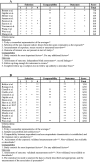The relationship between frailty and polypharmacy in older people: A systematic review
- PMID: 29575094
- PMCID: PMC6005607
- DOI: 10.1111/bcp.13590
The relationship between frailty and polypharmacy in older people: A systematic review
Abstract
Aims: Frailty is a complex geriatric syndrome resulting in decreased physiological reserves. Frailty and polypharmacy are common in older adults and the focus of extensive studies, although little is known about the impact they may have on each other. This is the first systematic review analysing the available evidence on the relationship between frailty and polypharmacy in older adults.
Methods: Systematic review of quantitative studies. A comprehensive literature search for publications in English or Spanish was performed on MEDLINE, CINAHL, the Cochrane Database and PsycINFO in September 2017 without applying restrictions on the date of publication. Studies reporting any relationship between frailty and polypharmacy in older adults were considered.
Results: A total of 25 publications were included, all of them observational studies. Evaluation of Fried's frailty criteria was the most common approach, followed by the Edmonton Frail Scale and FRAIL scale. Sixteen of 18 cross-sectional analyses and five of seven longitudinal analyses demonstrated a significant association between an increased number of medications and frailty. The causal relationship is unclear and appears to be bidirectional. Our analysis of published data suggests that polypharmacy could be a major contributor to the development of frailty.
Conclusions: A reduction of polypharmacy could be a cautious strategy to prevent and manage frailty. Further research is needed to confirm the possible benefits of reducing polypharmacy in the development, reversion or delay of frailty.
Keywords: frailty; older adults; polypharmacy; systematic review.
© 2018 The British Pharmacological Society.
Figures
References
-
- Fried LP, Tangen CM, Walston J, Newman AB, Hirsch C, Gottdiener J, et al Frailty in older adults: evidence for a phenotype. J Gerontol A Biol Sci Med Sci 2001; 56: M146–M156. - PubMed
-
- Rockwood K, Mitnitski A. Frailty in relation to the accumulation of deficits. J Gerontol A Biol Sci Med Sci 2007; 62: 722–727. - PubMed
-
- Jokanovic N, Tan EC, Dooley MJ, Kirkpatrick CM, Bell JS. Prevalence and factors associated with polypharmacy in long‐term care facilities: a systematic review. J Am Med Dir Assoc 2015; 16: 535.e1–535.e12. - PubMed
-
- Jyrkka J, Enlund H, Korhonen MJ, Sulkava R, Hartikainen S. Polypharmacy status as an indicator of mortality in an elderly population. Drugs Aging 2009; 26: 1039–1048. - PubMed
Publication types
MeSH terms
LinkOut - more resources
Full Text Sources
Other Literature Sources
Medical



